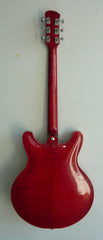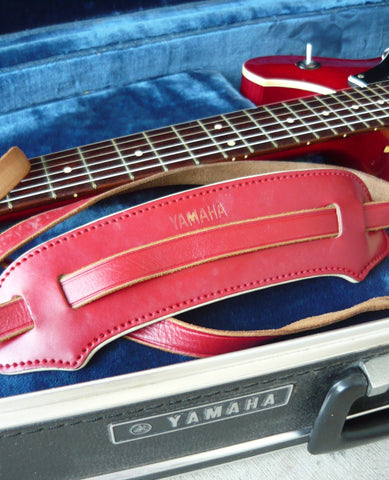Most of us know the name Yamaha. Either for their guitars, drums, keyboards or even motorbikes. Most of us also hopelessly underrate them as a guitar manufacturer. They have made some of the greatest guitars you will play, for much less than a US equivalent.
The company itself is the granddaddy of the Japanese musical instrument world. Started in the mid 1880's as a piano and organ manufacturer they joined the world of guitars as early as the mid 40's. Their attention to detail and craftspersonship has always been second to none, and not just with guitars. Unfortunately in Australia we tend to relate them to entry level nylon string acoustics or Pacificas (nothing wrong with either of them) and think of them as a "cheap Japanese import" guitar.
When the boom hit Japan in the mid 60's Yamaha was well primed to join the race. Having made guitars for longer than most of it's new competitors, they hit the ground running with the S201 and S301 (which turned into the SG2 and 3) in early 1966. This was the same year Yamaha set up a Custom shop (yeah, a custom shop in the mid 60's) to make high level acoustics that eventually went on to make acoustics for big name players like John Lennon, Paul Simon, John Denver and Bob Dylan.
Yamaha were more concerned with making high quality professional level guitars for the local domestic market and didn't actually start exporting huge numbers until the early 70's, mainly to the US.
While the SG prefix stood for "Solid Guitar" and would be made famous in the 70's by people like Santana, Bob Marley, Brian Robertson and MANY more, Yamaha used the SA prefix for their newly designed "Super Axe".

In '66 when Japanese companies were grasping for a piece of the overseas market, Yamaha designed and built a semi acoustic uniquely for the domestic market that didn't copy or follow design "rules" by Gibson or Gretsch. The SA5 was the first model to arrive in early '66 followed by the SA30 here. The T stands for "tremolo" but most were fitted with a vibrato with very few being made with a trapeze tailpiece. These were followed by the SA50 (upper market version with block inlays and binding etc), the SA15 (a semi based loosely on the then current production SG5's with longer bottom horn) and the SA20 (12 string version of the 50).

This model only ran from '66 to '72 when they were dropped from the catalogues while the SA90 and SA60 (basically the 50) kept on going and by '77 the whole range had been replaced by the SA1000 and 2000 which were a more traditional 335 shape are essentially still being made today.
Anyway, I digress (again) so lets take a look at this amazing Yamaha from 1966.
The quality of these is something to behold as anyone who has held a nice Yamaha will attest to. Their SG's and LP's (Lord Players) can be every bit as good as their Gibson counterpart and these have quality and beautiful design oozing out of them everywhere.

First off, I personally LOVE the shape. Those slightly curved in horns look great on a semi and the way the carved top forms in on those horns is beautiful. I have owned several hollowbodies in this shape although it appears other factories used this shape as these guitars weren't made by Yamaha and all had bolt on necks as apposed to set necks like Yamaha employed. I had an Emperador that used this shape and I have owned (and still own) Guyatones (more on them soon) with this body shape. It's not clear as to weather Yamaha licensed this shape to other factories or it was a combination of it being popular in Japan and not available OS that made other factories make a cheaper version for the non domestic market as well. Either way, it's a great shape.
The body is a thin full hollow body with rails running down the length under the bridge/pickup mounts. The construction is flawless and all the timber is high quality. The body and F holes are bound AND the F holes have inlays to fill the holes to stop (or at least help) with feedback .... amazing. It has a set maple neck of 24.75" scale. The fretboard is a very nice piece of rosewood and the 30 model didn't have neck binding or block inlays but much like the SG models, construction and timbers were basically the same as the higher end models. There is a zero fret (which of course I love) and the neck is a very comfortable "thin" playable neck.
Yamaha made all of their hardware and electronics in house so these pickups aren't available in other brands and all the hardware is of a very high quality. The pickups are loud and clear but not with too much output. They keep their "jangle" really nicely and the pots and switch are of a very high quality.
The interesting thing here is the wiring with a standard 3 way toggle, master volume and tone control but with the added versatility of a "Balance" pot which blends between the two pickups when in the middle toggle position. This gives an endless array of tones from such a simple set up.
The vibrato is very smooth and has adjustment for arm height/spring tension (attention to design is impeccable) and the intricate roller bridge is a piece of design beauty. Even the recessed output jack plate is a thing of beauty.

The original tuners are smooth and have a great ratio.
Like I've said, this thing oozes quality and that runs through to the original hardcase as well. It's a heavy case but beautifully finished in blue fuzz, aluminium edging and a Yamaha badge proudly placed on the outside. This guitar also has the original (matching red) Yamaha leather strap. All original and from the first year of manufacture and it still, over 50 years later plays like a dream.

It's a joy to play and honestly feels and sounds better than a lot of much more expensive and collectable hollow bodies I've played. Yamaha were really an amazing manufacturer in the 60's and 70's Japanese landscape as they're products were aimed squarely at domestic professional musicians rather than trying to flood the world with electric guitars. Even when they finally relented and started exporting, their quality showed through, and they were more expensive than cheaper competition too.
This will be for sale in the shop from this weekend. Drop in and have a play and you'll see for yourself what I'm raving about.













